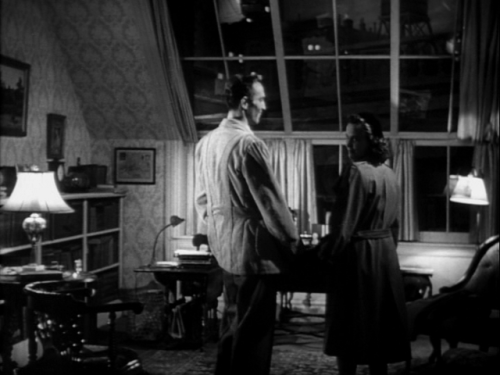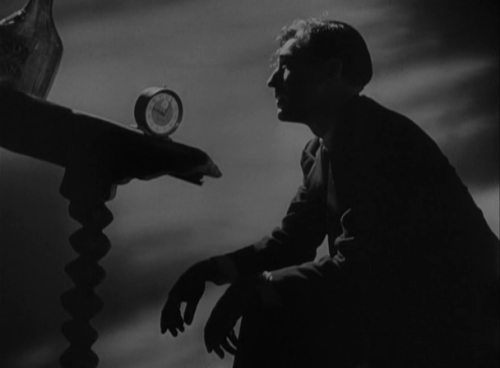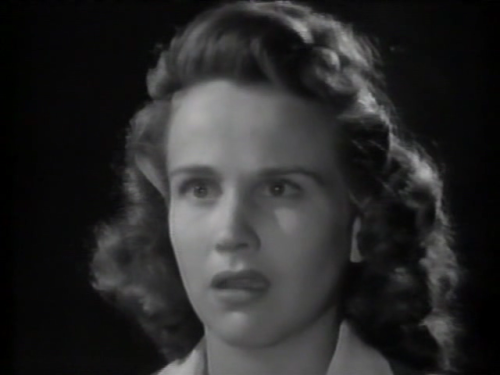
Val Lewton (and director Mark Robson)’s The Seventh Victim is a deeply divisive film. Extravagantly praised by some (although, to tell ya the truth, I don’t think it’s possible to overestimate this gently nihilistic slice of quotidian terror), it is just as often treated as a weak link in the Lewton series (generally by critics who deplore its choppy, bordering-on-incoherent narrative).
I want to tip my cap to Ed Howard for articulating his sense of the film’s “disjunctive” storytelling style–its strategy of narrative-progression-through-digression. He’s quite right. It’s a relay race through subjectivities (to the finish line of Lewton’s oft-quoted summation of the film: “Death is good”) that plays like an ultra-compressed precursor of my all-time favourite film, David Lynch’s Mulholland Dr. (which I read “super-oneirically”–in what remains my favourite on-line discussion–against the grain of the generally-accepted psychological–dream/reality–interpretation of the film, ably presented by Charles Reece).
Like Mulholland Dr., The Seventh Victim begins deep within the consciousness of a naive, curious and ultimately very forceful young woman. Kim Hunter’s Mary Gibson is really a unique presence (although she shares a number of traits with Teresa Wright’s Charlie Newton in Shadow of a Doubt–the ONLY female character in Hitchcock’s oeuvre who succeeds in “hijacking” the narrative–i.e. overpowering the director’s famed voyeuristic eye… amazingly–both of these movies premiered during the same week in August 1943!), a genuinely feminist agent (rather than the ultimately reactionary–because they reinforce male supremacy–“strong women” that Howard Hawks specialized in giving us). Nowhere is this more apparent than in the counter scene, in which she tells genial proto-patriarch Hugh Beaumont (who patronizingly asks her to drink her milk), “I don’t like to be ordered to do anything.” It’s an amazing moment–on a number of levels. Right on the surface, you just don’t SEE women in films from this period reacting to paternalistic “kindness” in this way. If a woman does assert her rights, it’s because the man has blatantly invited her ire (and often not even then). But on a more metatextual level, I like to read the milk as a rejection of the entire gothic noir tradition of female victimization represented by 1941’s Suspicion (whose most vivid scene features Joan Fontaine dutifully quaffing a glass of the white stuff that she suspects has been poisoned).

Time and again (and the fact that the whole movie only lasts 71 minutes always shocks me, because it literally contains multitudes), the story shows us Mary disarming and taking control of situations that genre and cultural expectations lead us to expect will overwhelm her——her bemused farewell to the clock as she leaves the sinister private school; her complete mastery–to the point that she actually orders him to his death–of Lou Lubin’s Irving August–introduced as a “wise guy” who seems likely to take her for a ride, but who exits as a soft-spoken and really quite tragic martyr to Mary’s strength (a fact that she recognizes and incorporates into her self-image, without allowing this knowledge to undermine her essential stance vis-a-vis the world); her deflection of Beaumont’s smugly proprietary maneuvers; her brazen invasion of the perfume works–worming information out of the always-wonderful Isabel Jewell; and her ability to go toe-to-toe with–and even coax some pretty decent behaviour out of–Tom Conway’s reborn Louis Judd (Simone Simon needed to become a monstrous panther before she could deal with him in Cat People.)
Mary Gibson is a complete hero. She is sensitive–and yet, she is not fazed by dire events. She makes mistakes and takes note of them. She completes investigatory tasks–and knows when to delegate them to others. And yet–she is in no way the complete film…
Because The Seventh Victim knows how to delegate as well.
Again, like Mulholland Dr., Lewton’s (and I do think it’s fair to call this Lewton’s film, rather than Robson’s, because the producer is completely responsible for its structure) story stretches across (at least) three separate subjectivities. Proponents of the Wizard of Oz-in-reverse interpretation of the Lynch film ignore the fact that Betty, Diane AND Adam all have a go at carrying the narrative. In The Seventh Victim, the key players are Mary, Jason (the Poet) and (Mary’s sister) Jacqueline (played by the enigmatic Jean Brooks).

 (She looks a lot like Hope Davis, doesn’t she?)
(She looks a lot like Hope Davis, doesn’t she?)
I’ve read criticisms on the IMDB from viewers who were annoyed that the film does not seem to know whose story is being told–and that’s a valid criticism if you’re proceeding upon psychological realist assumptions–however, I would submit that no one ought to watch this movie through that lens. To wit–The Seventh Victim tells Lewton’s story… and tells it perfectly. I’m not talking about concealed biography here (although many of the film’s contemporary champions do exactly that)–I’m talking about a magnificently talented auteur dipping into a very rich stream of consciousness(es), baiting his narrative hook for a “live one” that is running (against the current) toward death (which, don’t forget, is “good”) at the appropriate speed. And he eventually finds her, in Jean Brooks’ refugee from Satanism.
But not before traveling through the middle term of Jason Hoag, the once-productive poet who has fallen upon hard times, but whose existential and creative spirit is revived by contact with Mary. As this figure takes the subjective baton from the woman he loves, and begins his investigation of Jacqueline’s disappearance, we observe the ways in which even a defective–or, let’s face it, delusional–imagination can preserve (prevent?) a mind from tumbling into the abyss (is that good?). Some viewers seem to resent this poet–and when people criticize the film’s dialog, they usually cite his lines. After all, this is a guy who says things like: “I was hoping that this [Mary’s visit to his apartment] was your advent into my world–and instead it’s goodbye.”

I guess that kinda stuff could bother people, but I love it. Jason’s dialog seems to exist in order to prove Mrs. Romari right–i.e. that poetry and clowning are in fact the same thing. I couldn’t agree more. Jason exists in a kind of charmed (charmed enough, anyway) limbo between Mary’s vigorous curiosity and Jacqueline’s clear-eyed ennui.
And while he’s bumbling about through the satanic/literary underworld (which encompasses former dead-man–from Cat People–Louis Judd), the film surveys a plethora of damaged people, each of whom has negotiated his or her own separate peace with the existential facts of life and death. In a sense, everyone we meet is a “missing person” (which explains the incredibly poetic pan–accompanied by mournful backstories–across the faces of Mary’s fellow-yearners at the Missing Persons Bureau). But what the camera (unlike Mary) is seeking, is not reconciliation, but renunciation.
And Lewton (through Nicholas Musuraca’s extraordinary cinematography–essential to the effectiveness of this entire series) hits paydirt (with pre-dug six-foot trench eyes) with Jacqueline Gibson. And once we obtain a firm lock on her–after her blip of an introduction during Mary’s part of the film–we stick with her pretty much to The (and her) End. And the most important thing about Jacqueline’s escape from the softly horrible world that Lewton gives us is that she chooses it. Like Mary, Jacqueline refuses to imbibe from the (here literally poisoned) fount of arbitrary authority, although she does weaken when her beloved Frances Fallon (echoes of The Miracle Woman‘s Florence Fallon–who saves David Manners from killing himself? probably not) begs her to cut the scene short.

But Jacqueline ain’t goin’ out like that–and her friend realizes at the last moment that she isn’t meant to. What follows, after the Satanists dismiss the film’s third and most lucid reflector from their lair, has always read, to me, as a psychodrama (designed to clarify Jacqueline’s understanding of the world she–and, Lewton implies, WE–cannot help but deplore), rather than as an actual assassination attempt. Her harrowing journey home, beset by mute knife wielders and noisy, insensitive clowns, sets the final seal upon this woman’s premeditated decision to kill herself.
Jacqueline doesn’t need those devil-worshipers to speed her on her way. And she’s not afraid of them–only of the deeply fearful attitude toward life that these lost souls embody. In fact, the film is at its most perceptive when it points out that Satanism–just like any other religion, including the cults of Art or Romantic Love–is simply one of many possible buffers against the existential truth that guides Jacqueline’s ultimate behaviour. (And how amazing is it that Lewton charges Conway’s sleazy Louis Judd with the task of rebuking the Satanists for failing to live up to the injunction–contained within the Lord’s Prayer–to forgive those who trespass against us? You could argue that he’s telling us to dismiss this moralistic speech as pure bosh–OR, you could take it seriously, as I do, as yet another echo, from an unexpected source, of my favourite Emersonian dictum, from “Experience”–i.e. as long as we’re here, and despite the fact that we really have no escape from the void of solipsism–“Let us treat the men and women well: treat them as if they were real: perhaps they are. “)
Earlier in the film, Beaumont tells Mary/Kim Hunter that Jacqueline’s sense of human dignity depends upon a person’s ability to take sole responsibility for putting an end to the affair, at the time of his/her choosing. Coupled with our brief glimpse of what’s behind the door of room number 7, and the symbolic meaning of Brooks’ nightwalk, this information lays the groundwork for one of the most bracing scenes in the Lewtonian canon (and, indeed, in the history of cinema), in which the outward bound Jacqueline and the stricken, going-out-on-the-town Mimi (Elizabeth Russell) cross paths on their respective sprints toward death. The moment somehow gathers everything that has come before it into a glitteringly multi-perspectival dramatization of existence at the frayed edges of the dream of intersubjectivity (or, if you’re more of an opti-mystic type, the intersubjective dream!)
good afternoon friends!
Dave
Read Full Post »





















